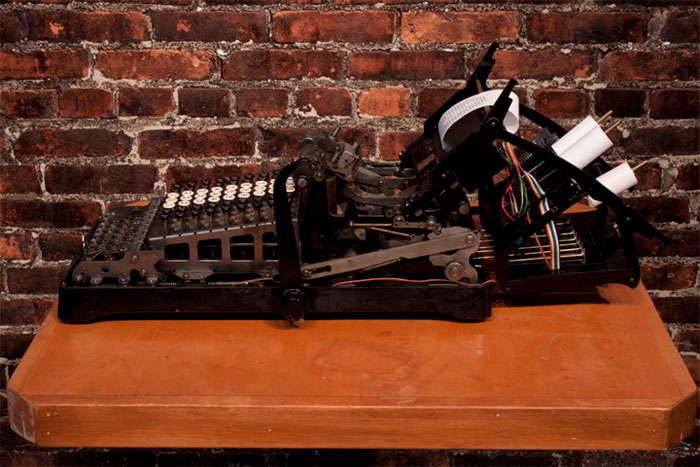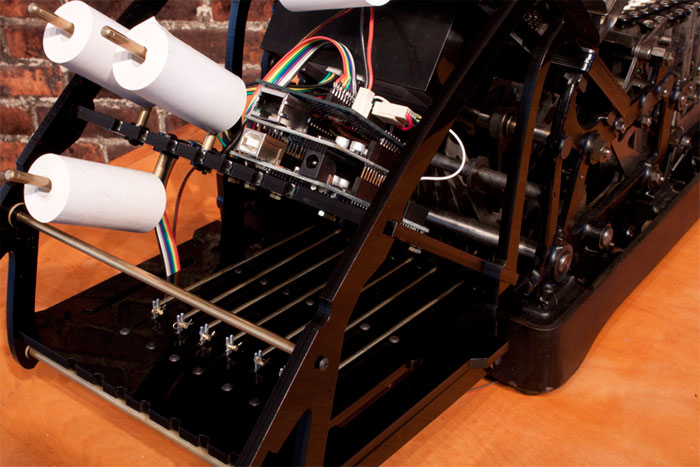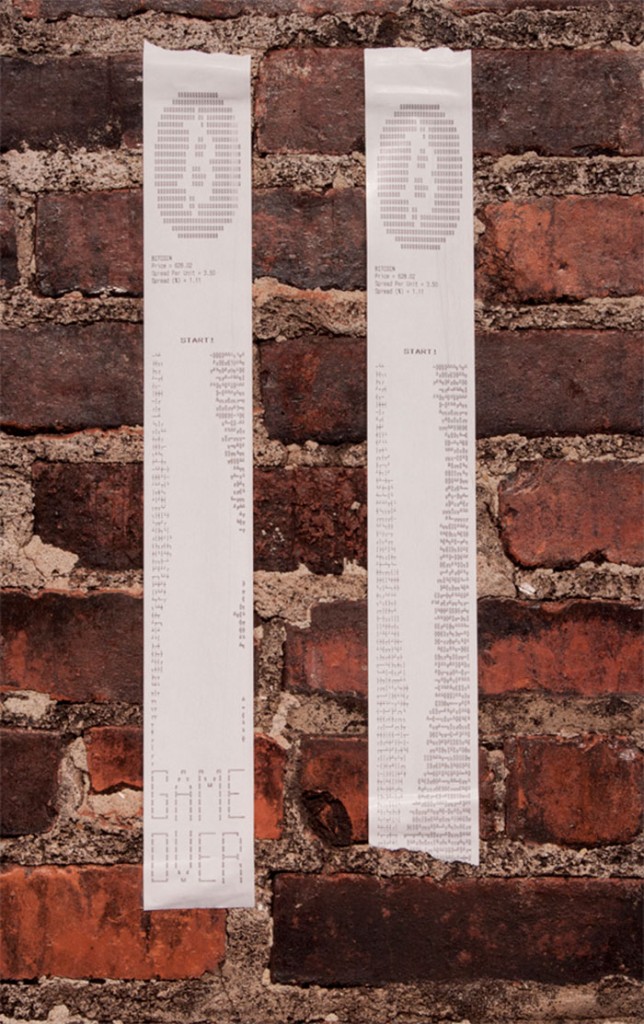Currency (2014), by Chris Wille and Brian Patrick Franklin, uses an antique Burroughs adding machine to control player movement on a constantly-printing roll of receipt paper. Players traverse levels generated by real-time Bitcoin exchange rates. Developer Chris Wille describes the project as “an ASCII generated 8 BIT game” modeled after Atari’s classic Defender (1981). But Currency throws players into a map generated by live financial information, not by some developer’s omnipotent hand. Everything about Currency challenges our commonsense classification of games as either “digital” or “analog,” from its paper display to its antique controller.
Linking analog computing technology (the adding machine) with digital networks (global financial systems), Currency places old and new technology in conversation with the player’s physical body. The tactile pleasures of cranking commands through a Burroughs machine remind us that lines between digital and analog gaming are socially constructed, historically contingent, and never completely stable. We’re reminded that analog networks of mail, radio, and telephone communication linked global financial systems together long before digitization and information theory took command. The distinctions between computer, electronic, digital, and tabletop gaming become uncertain, emphasizing the need for more specific language in our classification of various games.
In keeping with this issue’s theme – pushing game studies beyond the analog/digital divide – I asked Chris and Brian a few questions about their work. Since Currency pushes the notion of an 8-bit game beyond our typical computer-controller-display conventions, I wanted to ask the developers for a deeper sense of their understanding of gaming beyond the digital.
James A. Hodges: Currency uses economic machinery from a variety of eras – an adding machine from the early 20th century, a more contemporary receipt printer, and a digital link with cryptocurrency exchanges at https://www.cryptsy.com. The game brings together artifacts from before the Gold Standard, from material currency to relational currency. What do you see Currency telling us about the relationship between analog and digital machinery?
Brian Patrick Franklin and Chris Wille: We find the analog-to-digital relationship particularly interesting because it directly relates to the way in which we all use money today. We trust that the numbers we see on our banks’ websites have value, just like we have trust in the bills we hand someone, and just like we have trust in a bar of gold sitting in a reserve. While there is a nostalgic or emotional response to the physical pieces of paper and metal we hold in our hand, there is little difference between that and the 1’s and 0’s that automatically pay our gas bills each month.
Value exists in these items because we have collectively decided that it does, not due to a notion of intrinsic worth. While this is certainly not a new idea and far from a revolutionary statement, we’re fascinated by the way the existence of Bitcoin itself so plainly calls out this construct of worth. The very premise of the currency is that it will have value if enough people agree that it should; a conversation that occurs every time something new is used to barter, be it Bitcoins, paper money, Disney Dollars, or gold.
The digital extensions applied to the analog machinery in Currency are meant to call up these relationships between analog and digital currency and how we apply a sense of value to each.

Hodges: You mention on your website that Currency‘s use of receipt printing references the early stock exchange, and that Bitcoin-generated visual output is used as a “foil” to this decidedly analog technology. Can you elaborate a bit more on what qualities are accentuated by the foil-like relationship between old and new economic technologies?
Franklin and Wille: In our eyes, the most intriguing quality that is highlighted is the perspective of an economy as built by the modern DIY culture. Bitcoin stands in stark contrast to any official stock exchange with its crowd-regulated structure. While stock exchanges are centralized, often deriving their name from their location (i.e., New York Stock Exchange, London Stock Exchange, Hong Kong Stock Exchange, SIX Swiss Exchange, etc.), Bitcoin is completely decentralized. This decentralization – combined with a 24-hour trading window – makes Bitcoin a truly global endeavor, ignoring borders and cultural delineations. It is an equalizer. Authority is taken out of the hands of a government and relies on its users for regulation.
Hodges: Currency‘s combination of analog and digital computing techniques brings financial systems from multiple eras together in a kind of playful anachronism. Steampunk aesthetics that make similar kinds of connection have been growing in popularity over the past few years as well. How do you see currency relating with themes of anachronism and steampunk?
Franklin and Wille: Anachronistic themes permeate Currency. An adding machine feeds player input to an Arduino microcontroller. The Arduino is reconciling mechanical input with the digital information it gathers from its network. And, most playful, the complex calculations and processes within the modern Arduino chip are visualized as simple abstract shapes reminiscent of 8-bit tiles on a physical strip of paper.
In blending these eras, we don’t try to hide the contemporary technology at use in Currency. Instead we are quite honest with where one technology ends and another begins, letting each take ownership of their purpose within the overall functionality of the system. The mechanical parts are blatantly mechanical and the digital parts are blatantly digital. It’s the intersections of these elements that we find to be one of the most engaging aspects of the work.
While the extreme mechanical complexity of the adding machine leads people toward steampunk parallels, the comparison breaks down with the overt plastic structure and electronic inclusions of a microcontroller, sensors, and the wires that run between them.

Hodges: All of our talk about Currency’s commentary on computing and finance would be meaningless if the game didn’t receive input from a human player, with a physical body in physical space. How do players relate with the physical elements of Currency? How is Currency’s relation with physical space similar or different from other games you’ve worked on?
Franklin and Wille: Part of Currency‘s draw to players is the wonderful tactile sensation of the game console. The mechanical buttons respond to the player’s finger with a click that is unique to such a heavy mechanism. The arm that the player pulls down at the end of each turn produces an immensely satisfying ratcheting “ka-chunk.”
The receipt paper that provides the visual feedback is also a vital piece of the game’s physical experience. At the end of each game, the players tear off and take with them the length of receipt paper that holds their gameplay. Not only does this action leave players with a physical document of their experience, a receipt of their transaction with the game, but it points toward the external aspects of the systems behind the game. The same numbers that were influencing a specific round of this game are influencing the purchase of countless and unknowable items. This abstract Bitcoin data turns into physical property that affects the lives of people all across the globe.
Hodges: How does Currency fit within the classification schemes that we commonly use for games? Categories like “digital” and “analog” seem too narrow for a game like this. Talk of “electronic” games could sidestep this issue, but some of Currency‘s most pleasing elements come from its decidedly mechanical components. Since this issue of Analog Game Studies is all about breaking down the analog/digital division, what are your thoughts on the topic?
Franklin and Wille: Currency is a tough game to categorize. It’s not played on a screen or monitor. It has elements that are controlled by mechanical gears and levers and elements that are controlled circuit boards. Up to this point we’ve definitely had the luxury of skirting the issue by calling it whatever seemed appropriate at the time, usually “videogame” or “electronic game.” Videogame, however, is probably the most accurate classification for it, although it is a videogame with no traditional video or screen.
Currency shares a lot with the old Tiger handheld videogames from the late 1980s. While they are thought of as videogames, the monitors on these game systems were, in fact, simple LCD screens that displayed the action very slowly. The receipt paper that holds the gameplay for Currency could be considered an even slower video display, updating but not overwriting its frame once every few seconds. Yet, if sped up like a flipbook, it would display fluid animation of the level imagery.


